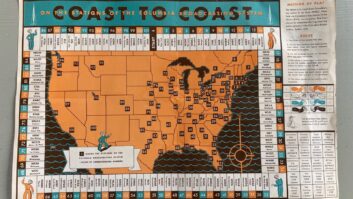
The striking Grace Digital Mondo internet radio.
Courtesy Grace Digital
OTTAWA, Ontario — About 20 years ago — the exact date has faded into the mists of history — Radio World International launched the RadioNet technology column.
Dedicated to examining “radio and the internet” — and the technology used to connect the two together — RadioNet began in the earliest days of internet radio. This is when 56 kbps dialup was the way most people accessed the web, rather than broadband. As a result, the internet radio feeds (now better known as streaming media) of those early days were extremely limited in bandwidth and fidelity, as were the station choices and avenues for listener response.
Today, everything has changed. Although internet radio has yet to replace AM and FM radio broadcasts (if that ever happens), it has definitely become a mass-market broadband medium via the streams of major public/commercial radio broadcasters online, feeds from web-only stations and major music streaming services such as Pandora and Spotify.
Jacobs Media Strategies (jacobsmedia.com), a longtime RadioNet expert source, has been surveying internet radio’s audience growth since 2005 through the company’s annual Techsurvey. “At that time, less than a quarter of our entire sample used streaming radio weekly or more often,” said Fred Jacobs, JMS’ president. “In our newest survey, nearly six in 10 listen to streaming weekly or more often. Streaming has gone from an activity that only a handful of techies used to do to a mainstream activity.”
BEGINNING
According to various historical sources, the first online webcaster was Internet Talk Radio, which was founded in 1993 by technologist Carl Malamud. (Given that the first listeners were tech-oriented, it makes sense that Internet Talk Radio featured computer expert interviews, not music.) A year later in November, WXYC(FM) in Chapel Hill, North Carolina, reportedly became the first traditional broadcaster to start streaming its programming online.
Slowly but surely, both broadcaster-run and web-only stations began to emerge onto the internet. In 1996, “Virgin Radio became the first radio station in Europe to stream online 24/7, under the excellent leadership of John Ousby,” said radio “futurologist” James Cridland, another long-time RadioNet expert contributor. “I was thrilled to work for Virgin Radio later as digital media director, and to make it the world’s most listened-to internet radio station for a while.”
As in the earliest days of broadcast radio, the primary challenge for pioneering webcasters was to find ways for listeners to hear them. At first, the pioneers solved this problem by creating their own individual “media players,” which listeners had to download and install on their own computers to tune in online. The downside is that you could end up using five different players to tune into your five favorite stations, which was hardly practical.
Eventually, third-party software developers created standalone software playout platforms (for streaming broadcasters) and players (for people to tune in online to multiple stations). The most notable of these was the RealAudio Player, which was launched in April 1995 and soon became the dominant (but not only) player platform.
“It was, for a long while, a mess of proprietary systems,” recalled Cridland. “RealAudio, Windows Media Player, Quicktime and Winamp meant you had to be really dedicated to listen. The audio sounded pretty poor, too: not just because of older encoders but because many broadcasters didn’t know how to effectively make and process audio for online.”
Today, the descendants of the earliest Quicktime and Windows Media Players remain in use, as do others made by other vendors. But although the RealPlayer still exists (and is available online at www.real.com), the company has lost its dominance, Cridland said. “As RealPlayer got progressively more stuffed with advertising and as Real got greedier with their server licenses, they underwrote their demise,” he said. “It’s a shame, since they were industry leaders in this space at one point.”

Virgin Radio’s Kerbango Internet Radio. Photo by James Cridland
KERBANGO
Since the paradigm of internet radio is of a radio connected to the Web, it didn’t take long for engineers to try making actual standalone “internet radios” that could function much like conventional AM/FM receivers. (RadioNet’s first such unit was a US$99 purple plastic receiver module that, although its audio was tinny and thin-sounding, actually managed to connect to the web quite reliably.) Unfortunately, these first efforts often fell short when it came to ease of use, audio quality and the ability to connect reliably and stay connected.
The revolutionary (and much-anticipated by RadioNet) Kerbango Internet Radio was meant to change all this. Often described as the first serious standalone internet radio receiver — it even looked and operated like an AM/FM radio — the Kerbango was developed just before the turn of the millennium. In addition to its radio-style interface, the Kerbango used many features found on modern internet radio receivers. They included logging onto an online site (in this case, RealAudio) to access a portfolio of streaming stations rather than tuning directly to individual station web sites, and being able to save presets on individual receivers.
“Virgin Radio had a Kerbango,” said Cridland. “I took it home once, ensured our stations were still available on it and took a few photographs.” (Those historic photos are featured in this article.) “It didn’t take off at the time because most people were still getting internet via dialup; and the Kerbango needed a network cable,” he added. Even if it had required a Wi-Fi connection, you probably wouldn’t have got one in most homes. It was way ahead of its time.”
Having received rave advance reviews, the Kerbango was close to commercial distribution when this promising startup was acquired by popular modem maker 3Com in 2000. Then the dot.com bubble burst, motivating 3Com to cancel the Kerbango in March 2001 as part of a $250 million cost-savings exercise. As a result, the first true internet radio receiver never made it to market.
“But the Kerbango’s spirit lives on,” said Cridland. “There are now plenty of internet radio receivers like it, plus Sonos and of course TuneIn on phones, tablets and other devices. I’ve worked with Pure, a company that makes internet radio sets. There’s a real consumer need for them.”

Grace Digital’s first product, the Grace Wireless internet radio. Courtesy Grace Digital
MOBILE LISTENING
The stillbirth of the Kerbango Internet Radio left a void that required people to stick to their computers to hear streaming audio, until they could start listening on their cellphones as well.
“When at Virgin Radio I launched the world’s first mobile phone app, in March 2005,” recalled Cridland. “We didn’t really know what to call it, so I went with the snappy ‘3G tuner.’ The issue at that time was that cellular companies were blocking mobile phones that had an activated Wi-Fi chip, so listening was expensive since it all had to go via the mobile data network. And the available bandwidth was low: We used an 8k stream in that app, so that it would work on a GPRS connection too.”
In 2016, things have changed; both due to the creation of powerful smartphones (literally handheld computers) and the arrival of high-bandwidth 4G/LTE cellular networks. “Now, of course, lots of internet radio reception is done on a mobile phone,” Cridland said. “The majority is done via Wi-Fi, not streaming: and the mobile apps are a little more sophisticated than our ‘3G tuner.’ Only now are we beginning to see personalized services from traditional radio broadcasters — ‘My Capital Xtra’ being a good example from the U.K., or NPR One from the U.S.” Another example is iHeartRadio.com in the U.S.

For 2016, Grace Digital’s CDI-IR2600 internet radio.
Courtesy Grace Digital
FINALLY
The death of the Kerbango Internet Radio only delayed the launch of standalone internet radio receivers. Other companies stepped up to seize this opportunity, from small specialty radio firms like the C. Crane Co. to multinationals such as Philips.
One company that has become a respected internet radio manufacturer is Grace Digital (gracedigital.com), co-founded by Jim Palmer (now Grace Digital’s president and managing director) and Greg Fadul (Grace Digital’s CEO) in 2007.
“I first started listening to streaming audio at a friend’s house via a Roku Soundbridge in 2004,” said Fadul. “A couple years later, when at the Hong Kong Electronics Fair, I met multiple companies including Frontier Silicon, BridgeCo and Reciva who were all offering internet radio modules that I found very intriguing.”
At that time, said Fadul, internet radio receiver manufacturers sold receivers that worked well but were too expensive for most consumers, or were affordable but didn’t work well. “My goal was to make a high-quality internet radio with great premium content that sold for under $200 — which no one had done at the time,” he said. That first receiver was the Grace Wireless Internet Radio — so-called because it connected to the web via users’ Wi-Fi networks — and it was priced at $199.99.
The gamble paid off: “Grace Digital started with one internet radio and now offers an entire line of internet radios from bedside alarm clocks, to internet radio tuners to connect to your home stereo, to micro stereo systems,” Fadul said. “Our growth has been healthy and consistently up through the years.”
TODAY, BEYOND
Twenty years after RWI began publishing RadioNet, much has changed. Online services such as Pandora, iHeartRadio and Spotify have made streaming audio commonplace for millions of listeners on computers and smartphones. Meanwhile, major broadcasters have moved headlong into internet radio, even though they “struggle with streaming for many reasons,” said Jacobs Media’s Fred Jacobs.
“They see streaming pure-plays failing to be profitable business, tethered by onerous music royalties … where each new listeners costs a streaming radio company more money, and the more they stream, the more the costs escalate,” he explained. In contrast, “the broadcast business model is much more elegant: Once you acquire a license, and invest in a tower, transmitter, and staff, the cost of acquiring a listener is inexpensive. And the more they listen, the better the ratings, and hence the revenue.”
Jacobs noted the new Nielsen software development kit that provides tools for app builder that counts online and mobile listeners in addition to those listening off-air. In the U.S., he said, “the new Nielsen SDK could change the game for radio and for audio streaming. If it’s successful — that means accepted by both broadcasters and agencies — it would open the door for more streaming. Radio would be much more willing to promote its streams on the air if it led to ratings and revenue.”
On the technology side, internet radio has moved from the desktop to mobile phones, and now into cars. In fact, “Internet radio is already massive in cars,” said Greg Fadul. “Whether you are streaming from your smartphone to your stereo or using your aux-in jack, the percentage of people using internet radio already is huge. And as car companies start embedding internet radio receivers into their cars instead of relying on secondary adjunct devices, internet radio usage will just continue to rise.”
Twenty years on, internet radio has grown from a techie niche passion to a mass-market medium. “IHeartRadio, Pandora, Sirius (via their app and internet radios), Spotify, Apple together have over 100 million listeners in the U.S. alone,” Fadul said. “That seems pretty mass-market to me.”
As for 20 years from now? “The future of radio is multiplatform — which includes broadcast as well as IP-based internet radio,” said Cridland. “So no, I don’t see internet radio being ubiquitous. I think it’ll be used more and more, but the benefits of broadcast radio are still strong. The clever operator will use the benefits of both, and invest in content to make the user experience amazing. I look forward to that.”
That said, RadioNet still would like to get a Kerbango Internet Radio, if there are any still left out there!
James Careless reports on the industry for Radio World from Ottawa, Ontario.










